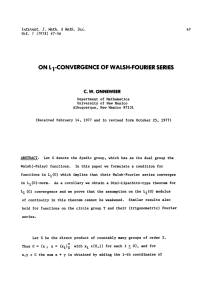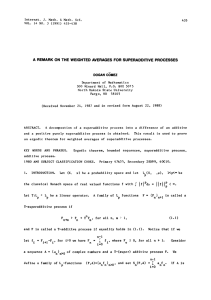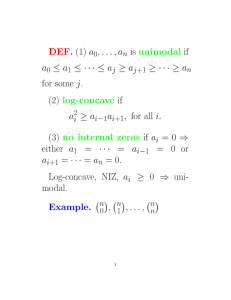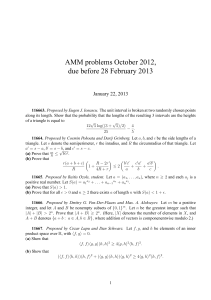A NOTE ON ABHYANKAR–MOH’S APPROXIMATE ROOTS OF POLYNOMIALS by Szymon Brzostowski
advertisement
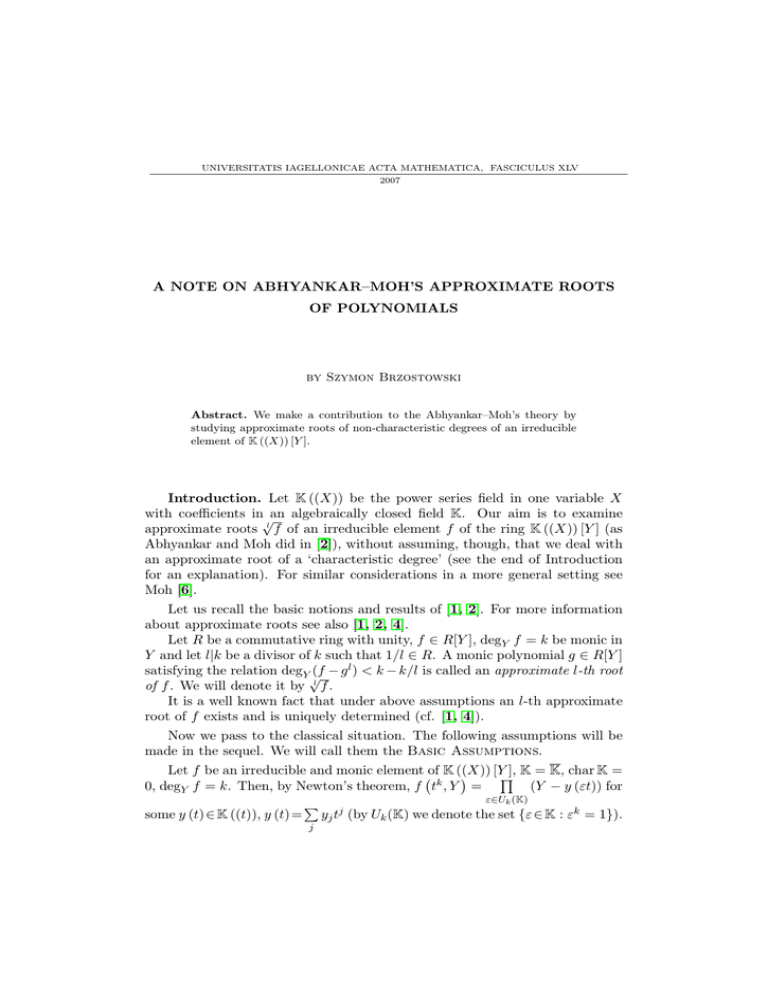
UNIVERSITATIS IAGELLONICAE ACTA MATHEMATICA, FASCICULUS XLV
2007
A NOTE ON ABHYANKAR–MOH’S APPROXIMATE ROOTS
OF POLYNOMIALS
by Szymon Brzostowski
Abstract. We make a contribution to the Abhyankar–Moh’s theory by
studying approximate roots of non-characteristic degrees of an irreducible
element of K ((X)) [Y ].
Introduction. Let K ((X)) be the power series field in one variable X
with coefficients in√an algebraically closed field K. Our aim is to examine
approximate roots l f of an irreducible element f of the ring K ((X)) [Y ] (as
Abhyankar and Moh did in [2]), without assuming, though, that we deal with
an approximate root of a ‘characteristic degree’ (see the end of Introduction
for an explanation). For similar considerations in a more general setting see
Moh [6].
Let us recall the basic notions and results of [1, 2]. For more information
about approximate roots see also [1, 2, 4].
Let R be a commutative ring with unity, f ∈ R[Y ], degY f = k be monic in
Y and let l|k be a divisor of k such that 1/l ∈ R. A monic polynomial g ∈ R[Y ]
satisfying the relation degY√
(f − g l ) < k − k/l is called an approximate l-th root
of f . We will denote it by l f .
It is a well known fact that under above assumptions an l-th approximate
root of f exists and is uniquely determined (cf. [1, 4]).
Now we pass to the classical situation. The following assumptions will be
made in the sequel. We will call them the Basic Assumptions.
Let f be an irreducible and monic element of K ((X))
[YQ], K = K, char K =
0, degY f = k. Then, by Newton’s theorem, f tk , Y =
(Y − y (εt)) for
ε∈Uk (K)
P
some y (t) ∈ K ((t)), y (t) = yj tj (by Uk (K) we denote the set {ε ∈ K : εk = 1}).
j
38
Further, let m = (m0 , . . . , mh ) be the characteristic of f (roughly speaking:
|m0 | = k, m1 = ordt y(t) and m2 , . . . , mh are consecutive exponents of the
Laurent expansion of y (t) such that gcd(m0 , . . . , mi ) < gcd(m0 , . . . , mi−1 ) for
2 6 i 6 h and gcd(m0 , . . . , mh ) = 1; for the definition see [1, Definition (6.8)])
and d = (d1 , . . . , dh+1 ), where dh+1 = 1, be the divisor sequence defined by
di = gcd(m0 , . . . , mi−1 ) for 1 6 i 6 h + 1.
It is also convenient to define the following derived sequences:
s = (s0 , . . . , sh+1 ),
P
putting s0 := m0 , si := m1 d1 +
(mj − mj−1 ) dj , for 1 6 i 6 h, and
26j6i
sh+1 := +∞;
r = (r0 , . . . , rh+1 ),
putting r0 := m0 , ri :=
si
di ,
for 1 6 i 6 h, and rh+1 := +∞;
n = (n1 , . . . , nh ),
putting ni =
di
di+1 ,
for 1 6 i 6 h.
Remark 1. Under an additional assumption char K - degY f , one can
extend the results of this work to the case of a positive characteristic.
We summarize basic properties of approximate roots in the following wellknown theorem ([1, Theorem (13.2) (i) and (ii), Theorem (8.2)]).
Abhyankar–Moh Theorem. If l = dj for some 1 6 j 6 h + 1 then:
√
1. dj f is irreducible in K ((X)) [Y ],
√
2. if 2 6 j 6 h + 1, then for every Puiseux root z(t) of dj f (t, Y ) there
exists ε ∈ Uk (K) such that
= mj ,
ordt y (εt) − z tk
3.
p ordt dj f tk , y (t) = rj .
In the sequel, we try to examine ‘non-characteristic’ approximate roots (i.e.,
we skip the assumption l = dj ) and to give some results similar to those stated
in the above theorem. More specifically: property 1 is not true (Example 1),
properties 2 and 3 carry over in the form of inequalities (Theorem 1, Corollary
1 and Theorem 3), which are then proved to be in fact equalities in some special
case (Theorem 2 and Theorem 3).
39
Auxiliary results. Throughout the work we freely utilize the notations
and results from [1]. We recall that the symbol −
o stands for an unspecified,
non-zero element of a field under consideration.
Under the Basic Assumptions, it is easy to prove the following lemma,
which is a slight improvement of Lemma (7.16) in [1].
Lemma 1. Let e be an integer such that 1 6 e 6 h and let K0 be a subfield
ofPK such that the k-th primitive root of 1 ∈ K belongs to K0 . Assume that
yj tj ∈ K0 ((t)). Then for every (e, U )-deformation y ∗ (t) of y (t) (i.e.,
j<me
an
of K0 ((t)), where K0 is an overfield of K, such that infot (y ∗ (t) −
Pelement
j
yj t ) = U tme ), there is
j<me
ne de+1 se
o U ne − ym
t with −
o ∈ K0 .
infot f tk , y ∗ (t) = −
e
Proof. We repeat the proof of (7.16) in [1] to obtain the equality (7.16.2):
infot (y ∗ (t)−y (wt)) = infot (y (t)−y (wt)) for a fixed w ∈ Q (e) = {ε ∈ Uk (K0 ) :
ordt (y (t) − y (εt)) < me }. Since, by assumption, incot (y (t) − y (wt)) ∈ K0 ,
then (7.16.3) takes the form
Y
−,
o
if e = 1
∗
infot
with −
o ∈ K0 .
(y (t) − y (wt)) =
−t
o se−1 −me−1 de , if e > 2
w∈Q(e)
The rest of the proof goes through without changes.
Next we need a version of the Newton Polygon Method, which is a consequence of [1, Theorem (14.2)]. For a more explicit formulation see also § 2.
in [5].
Proposition 1. Let g be an element of K ((X)) [Y] splitting into linear
factors of the form Y −zj (X), where zj (X) ∈ K X 1/M and 1 6 j 6 degY g.
P
Let us consider an arbitrary u (t) =
uj tj/M ∈ K t1/M , for some L ∈ Z.
j6L
Then the following two conditions are equivalent:
L
i) there exists 1 6 j 6 degY g such that ordt (u (t) − zj (t)) > M
;
L/M
ii) the polynomial h (U ) := incot g t, u (t) + U t
∈ K [U ] is not constant
and one of its roots is U = 0.
Furthermore, if U = 0 has multiplicity l > 0 as a root of h (U ), then
there exist at least l different indices j1 , . . . , jl ∈ {1, . . . , degY g} such that
L
ordt (u (t)−zji (t)) > M
for i = 1, . . . , l.
Now we can prove
Lemma 2. Let f fulfil the Basic Assumptions. Let l be an integer such
that l|di for some 1 6 i 6 h and l ∈
/ {d1 , . . . , dh+1 }, and assume that there
40
exists an integer m0 , mi−1 < m0 < mi (in the case of i = 1, we only demand
m0 < m1 ) such that gcd (di , m0 ) = l. Then for every Puiseux seriesz (t) with
√
l
f (t, z (t)) = 0 there exists ε ∈ Uk (K) such that ordt y (εt) − z tk > m0 .
Proof. Let Z be an indeterminate
over K and consider
y Z (t) = y (t) +
Q
0
Ztm ∈ K [Z] ((t)). Put f Z tk , Y =
Y − y Z (εt) . Then f Z (X, Y ) ∈
εk = 1
K[Z]((X))[Y ] has the characteristic sequence mZ = m0 , . . . , mi−1 , m0, m0i+1 , . . .
and the divisor sequence dZ = (d1 , . . . , di , l, . . . , 1). Notice that l >p1, because l 6= dh+1 . From the Abhyankar–Moh theory it follows that l f Z ∈
K [Z] ((X)) [Y ] is irreducible in K (Z) ((X)) [Y ]. Let
p
Y
l
f Z tk/l , Y =
(Y − z̄ (ε1 t)) ,
k/l
ε1 =1
where z̄ (t) ∈ K (Z) ((t)) has the property that ordt z̄ tl − y Z (t) = m0i+1 >
m0 ([1, Theorem (13.2) (ii)]).
P
Fix ε1 ∈ Uk/l (K) and consider z̄ (ε1 t). It follows that z ∗ (t) =
yj (ε1 t)j/l +
j<m0
m0 /l
U (ε1 t)
∈ K [U ] ((t)) is (i, U )-deformation of z̄ (ε1 t). Applying Lemma 1 to
p
l
f Z and z ∗ (t), we get
p d¯
o ∈ K.
o U n̄i − Z n̄i i+1 ts̄i with −
(1)
infot l f Z tk/l , z ∗ (t) = −
p
(Here the bar ‘− ’ indicates characteristic sequences for l f Z .) From the defip l
nition of the approximate root we conclude that degY (f Z − l f Z ) < k − kl .
Z
After the substitution Z = 0 in that inequality, we thus get degY (fZ=0
−
p
l
p
l
Z
= f . This means that l f Z Z=0 =
f Z Z=0 ) < k − kl . But, obviously, fZ=0
p
√l
f . Since l f Z tk/l , z ∗ (t) ∈ K [Z] [U ] ((t)), then substituting Z = 0 in (1)
we get
p ¯
¯
o di /l ts̄i with −
o ∈ K.
o di ts̄i = −U
infot l f tk/l , z ∗ (t) = −U
o n̄i di+1 ts̄i = −U
From Proposition 1 we conclude that there exist di /l Puiseux roots z!
j1 (t) , . . . ,
√
P
j/l
zjdi /l (t) of l f (t, Y ) such that m0 /k < ordt
yj ε1 tj/k − zjp (t) and so
j6m0
1/l
m0 < ordt y ε1 t − zjp tk
for p = 1, . . . , di /l.
1/l
(Above, ε1 denotes any of l-th roots of ε1 in K.) Since ε1 was a fixed element
of Uk/l (K), then we have proven that for any ε ∈ Uk (K) there exist di /l
41
√
Puiseux roots zε,1 (t) , . . . , zε,di /l (t) of l f (t, Y ) such that
ordt y (εt) − zε,p tk
> m0 for p = 1, . . . , di /l.
Now for A = εdi : ε ∈ Uk (K) there is card A = k/di and if σ1 ,σ2 ∈ Uk (K),
σ1di 6= σ2di , then ordt (y (σ1 t) − y (σ2 t)) < mi−1 < m0 . Thus
ordt zσ1 ,p1 tk − zσ2 ,p2 tk
< m0 for p1 , p2 = 1, . . . , di /l.
√
Since dki dli = kl = degY l f , the lemma is proved.
Property 1. Let g ∈ K ((X)) [Y ], degY g = k, g = g1 · . . . · gr be the
decomposition of g into irreducible
factors in K ((X))N[Y ]. Let N be Na pos
itive integer such
that
gcd
N,
=
1.
Then
g
X
=
g
X
·
k!
,
Y
,
Y
1
. . . · gr X N , Y is the decomposition of g X N , Y into irreducible factors in
K ((X)) [Y ].
roots of g(t, Y ),
Furthermore,
if z1 (t) , . . . , zk (t) are all Puiseux
then z1 tN , . . . , zk tN are all Puiseux roots of g tN , Y .
Proof. It is enough to prove the property under the assumption that g is
irreducible in K ((X)) [Y ]. Let g have characteristic m = (m0 , .. . mh ),
deg
Y g =
k and z (t) be any of Puiseux roots of g(t, Y ) = 0. Since g tk , z tk = 0,
then g tkN , z tkN = 0 with gcd k, Supp z tkN
= 1. Thus g X N , Y
is irreducible in K ((X)) [Y ] and the characteristic sequence of g X N , Y is
(m0 , N m1 , . . . , N mh ).
Main results. Our first theorem is an improvement of Lemma 2. It is
a generalization of the item 2 in Abhyankar–Moh Theorem covering the noncharacteristic case.
Theorem 1. Let f fulfill the Basic Assumptions. Let l be such an integer
that l|di for some
/ {d1 , . . . , dh+1 }. Then for every Puiseux
√ 1 6 i 6 h and l ∈
series z (t) with l f (t, z (t)) = 0 there exists ε ∈ Uk (K) such that
(2)
ordt y (εt) − z tk
> mi .
Proof. Let M = k! and let N be any positive integer such that (N, M ) = 1.
Then by Property 1, f X N , Y is irreducible in K ((X)) [Y ] and has the characteristic (m0 , N m1 , . . . , N mh ) (see the proof of Property 1). If N is large
enough, then there exists such an integer m0 that N mi−1 < m0 < N mi and
gcd (m0 , N m1 , . . . , N mi−1 , m0 ) = l (if i = 1, then we demand m0 < N m1
and gcd (m0 , m0 ) = l). Consequently, f1 := f X N , Y fulfills the assumptions of Lemma 2. We conclude that for every Puiseux series
z̄ (t)
with
√
l
f1 (t, z̄ (t)) = 0, there exists ε ∈ Uk (K) such that ordt y εtN − z̄ tk > m0 .
42
√
√
But it is evident that l f1 (X, Y ) = l f X N , Y . And so, by
Property 1,
√l
N
there exists a Puiseux root z (t) of f (t, Y ) such that z t
= z̄ (t) and
ordt y εtN − z tkN > m0 , or in other words
(3)
ordt y (εt) − z tk
> m0 /N .
√
From Property 1 it follows that every Puiseux root of l f (t, Y ) satisfies the
above inequality.
Choosing a suitable N tending to infinity, we will now improve (3) to
obtain inequality (2). By Dirichlet’s theorem, the sequence {1 + j · di l}j∈N
contains infinitely many prime numbers. Let {Np }p∈N = {1 + jp · di l}p∈N be
the sequence of primes. Let A := mi − l. Now we can write
Np mi = mi + jp · di lmi = (mi − l) + (di mi jp + 1) l = A + (di mi jp + 1) l.
Taking a large enough r ∈ N we define B := A + jr · di lmi (or, respectively,
B := A − jr · di lmi if mi < 0) with the property that B > 0. For p > r we now
obtain
Np mi = B + (di mi (jp ∓ jr ) + 1) l = B + m0p ,
taking m0p = (di mi (jp ∓ jr ) + 1) l. Here gcd di , m0p = gcd (di , l) = l for
p > r. Since m0p = Np mi − B and B > 0, then m0p < Np mi , and for a p
large enough, also Np mi−1 < m0p if i > 1. Obviously, we can also assume that
gcd (Np , M ) = 1.
√
Fix a Puiseux series z(t) satisfying l f (t, z(t)) = 0. From the first part of the
proof it follows that for every N = Np , p 0, there exists εp ∈ Uk (K) such
that
ordt y (εp t) − z tk
> m0p /Np = mi − B/Np .
We conclude that there exists an ε ∈ Uk (K) such that
ordt y (εt) − z tk
> mi − B/Np
for infinitely many p ∈ N. Since B is constant and Np tends to infinity with p,
then it means that
ordt y (εt) − z tk
> mi .
Thus the theorem is proved.
Remark 2. The construction of the sequence {Np } can be simplified: demanding only that the sequence {Np mi − m0p } should be bounded, there is no
need to use Dirichlet’s theorem.
43
Corollary 1. For a given integer l|d1 , the above theorem is true with
i = max{1 6√j 6 h + 1 : l|dj }. If, in addition, l > di+1 , then for every Puiseux
root z (t) of l f (t, Y ) and every σ ∈ Uk (K) there holds
ordt y (σt) − z tk
6 mi .
Proof. The first part of the
corollary is obvious. As for the second
√ one, if
there were ordt y (σt) − z tk > mi , for some Puiseux root z (t) of l f (t, Y )
and some σ ∈ Uk (K), then
j/di+1
X
X
z(t) =
yj (σ j tj/k ) + . . . =
yj σ j t k/di+1 + . . .
j 6 mi
j 6 mi
and since
gcd (k/di+1 , m1 /di+1 , . . . , mi /di+1 ) = 1, there would also hold
√
degY l f > k/di+1 and so k/l > k/di+1 , which is impossible by the assumption.
Combining Theorem 1 and Corollary 1, we get
Theorem 2. Let f fulfill the Basic Assumptions. Let l be an integer such
that l|d1 and l ∈
/ {d1 , . . . , dh+1 }. Define i =√max{1 6 j 6 h + 1 : l|dj }. If
l > di+1 , then for every Puiseux root z (t) of l f (t, Y ) and every σ ∈ Uk (K),
6 mi .
ordt y (σt) − z tk
Furthermore, there exists an ε ∈ Uk (K) such that
= mi .
ordt y (εt) − z tk
Theorem 3. Let f fulfill the Basic Assumptions. If l is an integer such
that l|d1 and l ∈
/ {d1 , . . . , dh+1 }, then for i = max{1 6 j 6 h + 1 : l|dj }:
p di
ordt l f tk , y (t) > ri .
l
If, in addition, l > di+1 , then the equality holds.
Proof. The concept of the proof is similar to that of the proofs of Lemma 2
and Theorem 1, so we will just sketch it, omitting the details.
1. First we return to the proof of Lemma 2. Assume accordingly, that
there exists an integer m0 , mi−1 < m0 < mi (or simply m0 < m1 for i = 1)
such that gcd (di , m0 ) = l. Defining y Z (t), f Z , z̄(t) as in that proof, we obtain
p
p
Q
l Q l
f Z tk/l , Y =
(Y − z̄ (ε1 t)) and so l f Z tk , Y
=
Y − z̄ (εt)l .
k/l
ε1 =1
= z̄ tl +V tα
εk =1
We put z V (t)
∈ K (Z) [V ] ((t)), where α > mi is chosen in such a
Q
l
way that gcd k, Supp z̄ t , α = 1. Let hZV tk , Y =
Y − z V (εt) . Then
εk =1
44
hZV (X, Y ) ∈ K[Z, V ] ((X)) [Y ] is an irreducible element of K (Z, V ) ((X)) [Y ].
l
Z
By [1, Theorem (13.2)
(ii)], we can Vassume that mi =0 ordt (z̄ t 0− y (t)) =
V
Z
ordt z (t) − y (t) , and so ordt z (t) − y (t) = m . Since m is the i-th
characteristic exponent of z V (t), from Lemma 1 we get
dZV
ZV
i+1 sZV
infot hZV tk , y (t) = −
o 0 − Z ni
t i with −
o ∈ K,
where the superscript ‘ZV ’ indicates characteristic sequences for hZV . But this
implies that also
ZV ZV
ZV
ZV
ZV
k
infot hZV
t
,
y
(t)
= −Z
o ni di+1 tsi = −Z
o di tsi with −
o ∈ K.
V =0
p l
l
f Z , we thus get
Since, obviously, hZV
=
V =0
p ZV
ZV
(4)
infot l f Z tk , y (t) = −Z
o di /l tsi /l with −
o ∈ K.
We now notice that sZV
= si + (m0 − mi ) di and so, having substituted Z = 0
i
in (4),
d
p di
i
ordt l f tk , y (t) > ri +
m0 − mi .
l
l
2. Now we return to the proof of Theorem 1. Constructing a sequence
of primes {Np }p∈N as in that proof and applying Property 1, we improve the
above inequality to
d
p const
i
ordt l f tk , y (t) > ri −
l
Np
and so
d
p
i
l
f tk , y (t) > ri .
l
Finally, from [1, Theorem (8.5)] it follows that in the case of di+1 < l, √
the
equality has to hold in the above formula. Indeed, let g1 = Y and gj = dj f
for 2 6 j 6 h + 1. Then for G = (g1 , . . . , gh+1 ) we obtain the G-adic expansion
√
√
d /l
di
, and so, by [1, Theorem
of l f in the form l f = gi i + . . . , because dli < di+1
√l
di
k
(8.5)], ordt f t , y (t) 6 l ri .
ordt
Example 1. In general nothing can be said about the (ir)reducibility of
non-characteristic approximate roots. Take the parametrization X = t48 , Y =
1/(t36 ) + 1/(t6 ) + 1/(t5 ) and let f ∈ C ((X)) [Y ] be its minimal monic polynomial.
f = Y 48 + . .. . It can be verified that for l = 2, there is
√l Then
8
6
incot f t , 1/t + 1/t + U · t = 4096 −51 + 8U 3 and so, by [1, Theorem
√
(14.2)], l f splits into three irreducible factors in C ((X)) [Y ] each of them
having a Puiseux root of the form t−3/4 + t−1/8 + −
o t1/8 + h.o.t. It is worth
45
noticing that the divisor l = 2 here is very ‘regular’, as d4 = 1|2|d3 = 6 and,
despite of that, irreducibility does not follow.
It is also easy to give examples in the other direction. Let X = t18 , Y =
−12
t +t−2 +t−1 , l = 3 and let f ∈ C ((X))
monic polynomial.
√ [Y ] be its minimal
√
Then f = Y 18 + . . . . There is incot l f t6 , 1/t4 + U t = 9U 2 − 6, so l f is
irreducible.
To end with, let us mention that the restriction l > di+1 made in Theorem 2
and Theorem 3 does not seem to be indispensable; in fact, we were not able to
find any counterexample to their respective conclusions. An interesting insight
gives the following example, which is a slight modification of the one above.
Example 2. Let X = t18 , Y = t−12 +at−3 +bt−1 , where a, b are indeterminates over C, l = 2. Then l =√2 < di+1 = 3, so the assumption l > di+1 is not
fulfilled. In spite of that incot l f t6 , 1/t4 + U/t = −27/2·U (−2U 2 +3a2 ). We
√
conclude that l f has√two non-conjugate Puiseux roots. One of them is of the
−3 + bt−18 ,
form z1 (t) = t−2/3 + 6/2 ·
a · t−1/6 + h.o.t., whereas y(t) = t−12 + at
√
l
so still ordt y (t) − z1 t18 = −3 = m2 . Also ordt f t18 , y (t) = r2 dl2 =
−81.
We state
Problem 1. Can we drop the assumption l > di+1 from the formulation
of Theorem 2 and Theorem 3?
√l
√lProblem 2. If f is reducible in K ((X)) [Y ], do the degrees of the factors
of f divide k?
References
1. Abhyankar S. S., Expansion Techniques in Algebraic Geometry, Tata Institute of Fundamental Research, Bombay, 1977.
2. Abhyankar S. S., Moh T. T., Newton–Puiseux expansion and generalized Tschirnhausen
transformation I, II, J. Reine Angew. Math., 260 (1973), 47–83 and 261 (1973), 29–54.
3. Abhyankar S. S., Moh T. T., Embeddings of the Line in the Plane, J. Reine Angew. Math.,
276 (1975), 148–166.
4. Gwoździewicz J., Ploski A., On the approximate roots of polynomials, Ann. Polon. Math.,
LX.3 (1995), 199–210
5. Moh T. T., On approximate roots of a polynomial , J. Reine Angew. Math., 278 (1974),
301–306.
6. Moh T. T., On the Concept of Approximate Roots for Algebra, J. Algebra, 65 (1980),
347–360.
7. Ploski A., Pierwiastki aproksymatywne wielomianów wedlug S. S. Abhyankara i T. T.
Moha, Materialy XIV Konferencji Szkoleniowej z Teorii Zagadnień Ekstremalnych, Wyd.
UL., Lódź, 1993, 45–52.
46
8. Ploski A., Twierdzenia podstawowe o pierwiastkach aproksymatywnych wielo-
mianów, Materialy XV Konferencji Szkoleniowej z Analizy i Geometrii Zespolonej,
Wyd. UL., Lódź, 1994, 51–61.
9. Sathaye A., Generalized Newton–Puiseux Expansions and Abhyankar–Moh Semigroup
Theorem, Invent. Math., 74 (1983), 149–157.
Received
February 1, 2007
Faculty of Mathematics
University of Lódź
ul. Banacha 22, Lódź
Poland
e-mail : brzosts@math.uni.lodz.pl
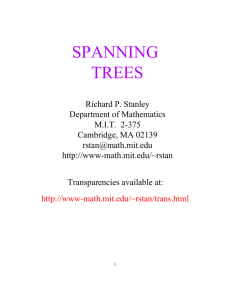
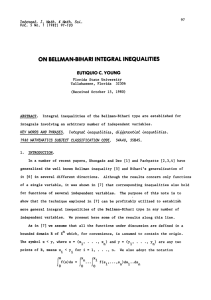
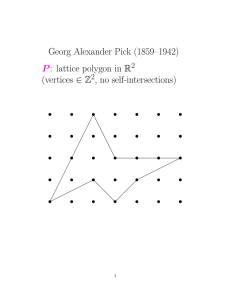
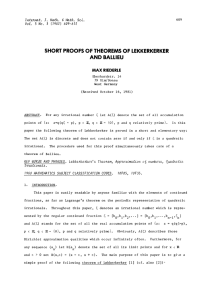
![5.5 The Haar basis is Unconditional in L [0, 1], 1 < 1](http://s2.studylib.net/store/data/010396305_1-450d5558097f626a0645448301e2bb4e-300x300.png)
